the place where Paleontology and Paleoanthropology meets Philately
2023
Dinosaurs and other prehistoric animals, fossils,
fossil-found places, paleontologists and contributors to Paleontology
and Paleoanthropology as well as Natural History Museums on
stamps, postmarks and postal stationeries issued in 2023
If you know about any other Philatelic item related to Paleontology or Paleoanthropology issued this year which is not mentioned below, please inform me.
|

|
Do you have any questions or want to talk about your hobby
with collectors who share the same interest? Looking for swap partners ? Join more than 1.600 members of the "PaleoPhilately" group on Facebook |

|
| 2024, 2023, 2022, 2021, 2020, 2019, 2018, 2017, 2016, 2015, 2014, 2013, 2012, 2011, 2010, 2009, 2008, 2007, 2006, 2005, 2004, 2003, 2002, 2001, 2000, 1999, 1998, 1997, 1996, 1995, 1994, 1993, 1992, 1991, 1990, 1989, 1988, 1987, 1986, 1985, 1984, 1983, 1982, 1981, 1980, 1979, 1978, 1977, 1976, 1975, 1970-1974, 1960-1969, 1950-1959, 1840-1949 |
 |
It also is useful for improving the quality of my website from the feedback received.
In 2023 "Paleophilatelie" website participated in three International Stamps Exhibits, where it was awarded one
LARGE GOLD Medal and two
Large Vermeil Medals.
The LARGE GOLD Medal was awarded in the 18th New Zealand National Philatelic Literature Exhibition 2023 in Christchurch, New Zealand.
One Large Vermeil Medals was awarded in Great American Stamp Show (GASS) 2023 in Cleveland, Ohio, USA.
Another one was awarded in IBRA 2023 in Essen, Germany.
For more details, please click here.
Some Books about Dinosaurs and other prehistoric animals, issued or coming soon this year:

|

|

|
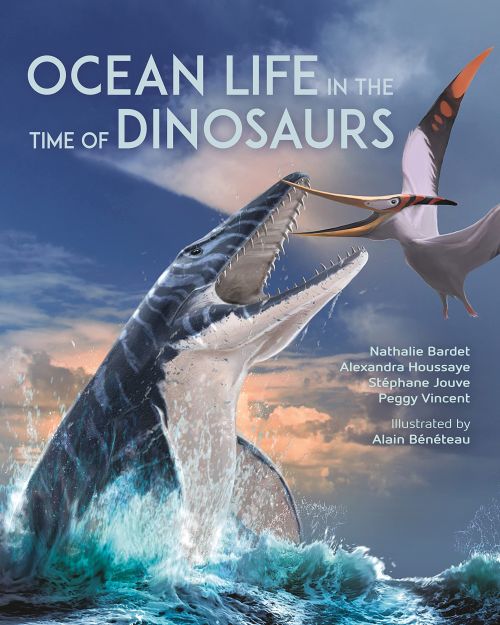
|
|
"Dinosaur World: Over 1,200 Amazing Dinosaurs, Famous Fossils, and the Latest Discoveries from the Prehistoric Era" Amazon: USA, UK, DE. |
"Dinosaur Behavior: An Illustrated Guide" Amazon: USA, UK, DE. |
"Ancient Sea Reptiles: Plesiosaurs, Ichthyosaurs, Mosasaurs, and More" Amazon: USA, UK, DE. |
"Ocean Life in the Time of Dinosaurs" Amazon: USA, UK, DE. |
Official stamps directly related to Paleontology: dinosaurs and other prehistoric animals, fossils, paleontologists
| 21.12.2023 - Mongolia | 12.12.2023 - Peru | |
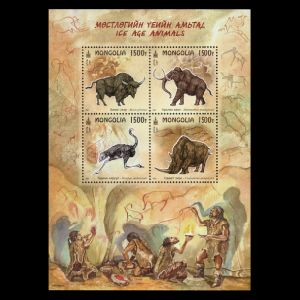 |
 |
|
| 10.11.2023 - Russia Boycott Russia [2] | ||
 |
||
| 28.07.2023 - Mexico | 21.04.2023 - Spain (ATM stamp) | 19.04-23.04.2023 - Spain (ATM stamp) |
 |
 |
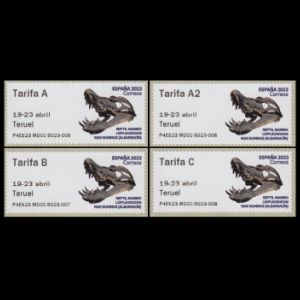 |
| 19.04-23.04.2023 - Spain (ATM stamp) | 19.04.2023 - Spain | |
 |
 |
 |
| 07.04.2023 - Bulgaria | 17.02.2023 - Isle of Man Post [1] | 17.02.2023 - Russia Boycott Russia |
 |
 |
 |
|
Paleontology related stamps of countries who issue too many stamps per year,
stamps with prehistoric animals or their fossils without any relation to the issuing country
or stamps with inaccurate reconstruction of prehistoric animals.
These stamps are not recommended for serious collectors and are Undesired at serious philatelic exhibits. |
||
| Burundi [5] | Central African Republic [4] | Chad |
 |
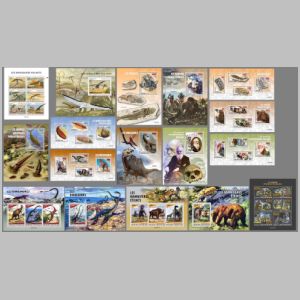 |
 |
| Djibouti [3] | Guinea [3] | Guinea Bissau [3] |
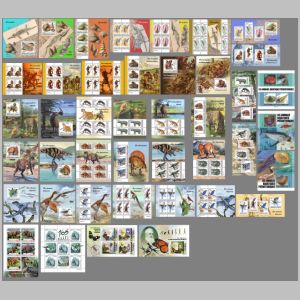 |
 |
 |
| Liberia [3] | Niger [3] | Sierra Leone [3] |
 |
 |
 |
| Togo | ||
 |
|
|
Notes:
On February 24th, 2022, the Russian army invaded the territory of Ukraine and is currently bombing peaceful cities and killing civilians across Ukraine.
Please think twice before buying Russian philatelic materials - even buying stamps or covers, indirectly supports their aggression against Ukraine, a free and independent European country.
 Image credit: www.ukraine-war-in-philately.eu - Ukrainian resistance to
Russian aggression through Philately.
Image credit: www.ukraine-war-in-philately.eu - Ukrainian resistance to
Russian aggression through Philately.
I'm, Michael Kogan admin and owner of this website, call all my visitors from around the world to boycott Russia - don't give your money to the country to kill Ukrainian citizens and destroy Ukrainian cities.
 |
| Ammonite on stamp of Isle of Man 2023 - part of "Manx Wildlife Trust 50th Anniversary" set. |
[1] One of the stamps from the "Manx Wildlife Trust 50th Anniversary" set, shows an Ammonite.
"Ammonite fossil, Ammonoidea: Arguably the most recognisable of fossils and are the remains of an extinct marine mollusc. Scarlett, in the south of the Island, is known for its interesting geology and fossils along with incredible wildlife, all on display at the MWT Nature Discovery Centre there. Palaeontology helps direct conservation efforts through better understanding of the causes of extinction."
[2] On November 10th, 2023, Russian Post issued the set of Souvenir-Sheets with stamps from "Paleontologic Heritage of Russia" from 2020 and "Fauna of Russia. Mammoth fauna", issued earlier this year.
[3] All “165 years since Charles Darwin publishes his theory of evolution” stamps, produced by Stamperija for different countries, were based on the same design.
 The countries from left to right: Djibouti, Guinea-Bissau, Guinea, Liberia, Niger, Sierra Leone.
The countries from left to right: Djibouti, Guinea-Bissau, Guinea, Liberia, Niger, Sierra Leone.[4] The Mini-Sheet “Prehistoric people” issued for the Central African Republic, by Stamperija in 2023, repeats the same design as from 2013.

[5] According to Stamperija, since 2021 Burundi became their client again. In 2023, Stamperija produced many stamps for Burundi, including reprints of stamps issued in 2012 and 2013. They used the same, but other face values.
Some personalized stamps related to Paleontology: prehistoric animals and their fossils
| 24.11.2023 - Czech Republic [SP1] | 14.11.2023 - Netherlands | ?.09.2023 - Portugal |
 |
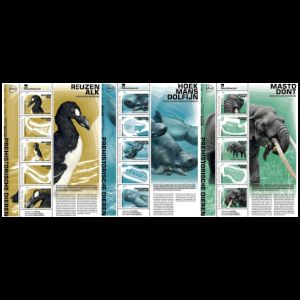 |
 |
| 26.09.2023 - Netherlands | 08.09.2023 - Czech Republic [SP1] | 04.07.2023 - Czech Republic [SP1] |
 |
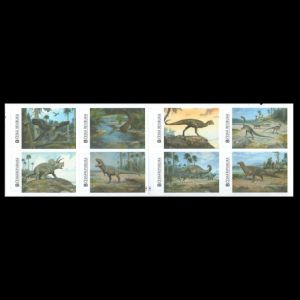 |
 |
| 13.06.2023 - Netherlands | 24.03.2023 - Czech Republic [SP1] | ??.??.2023 - Gibraltar |
 |
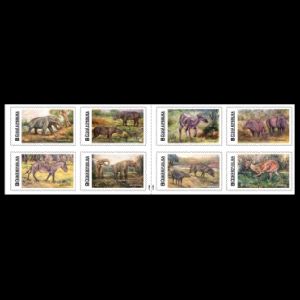 |
 |
Notes:
[SP1] Several booklets of 8 self-adhesive stamps each, were issued this year by the Fauna-Flora Philatelic Society of the Czech Philatelists Association.
The face value "B" corresponded to the rate of small domestic letter and was equivalent to 27 CZK or €1.10 in 2023.
Since 2019 the Society has produced many philatelic materials of all kinds of "Flora and Fauna" topics, both modern and prehistoric. The Society is led by Mr. Vaclav Fiala, who sells their philatelic productions on the internet, for a very expensive price. The package of a booklet, FDC and Maxi Cards cost more than €300-€350 on average. Below are the screenshots of the offers of Mr. Fiala:
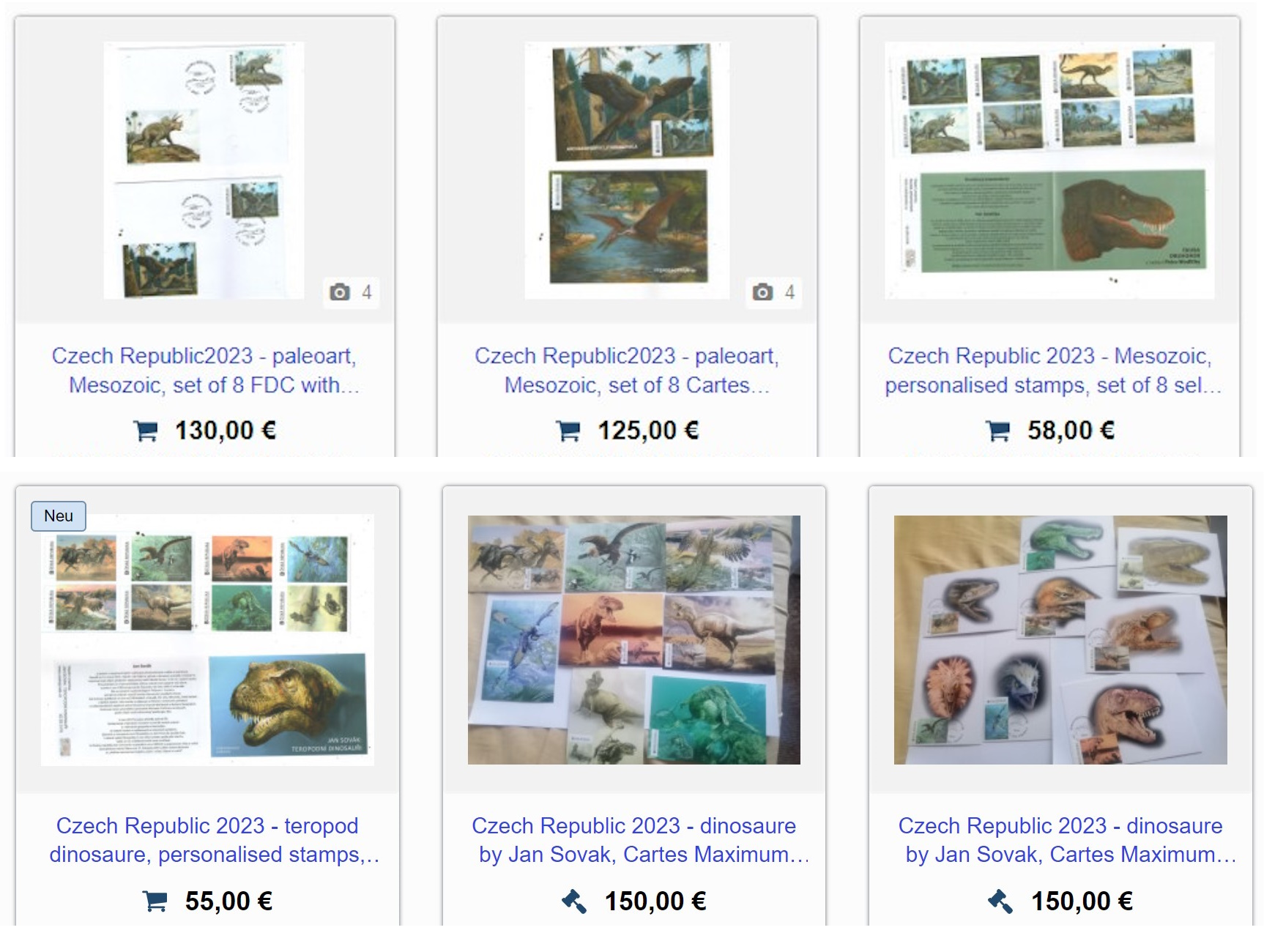
These beautiful stamps reproduce paintings of Czech's paleoartists.
The first booklet, "Tertiary period animals", was presented at the Sberatel philatelic stamp show on March 24th 2023, in Prague.
These stamps reproduce paintings created by Czech Painter and Illustrator Arnost Hanak.
Together with the stamps set, the Society issued a postmark with the head of Deinotherium. The Deinotherium skeleton was discovered near Horni Ves in Chebsk in 1883 and became a part of the collection of the Natural History Museum in Vienna.
I've been painting ever since I was ten years old, when I discovered the books
Zavátý život and Wonders of the Ancient World by
Josef Augusta with illustrations by Zdenek Burian in the library
said Hanak on the stamps set presentation. [R7]
 |
| Mesozoic Fauna postmark of Petr Modlitba. |
 |
| Therapod Dinosaurs postmark of Jan Sovak. |
Petr Modlitba born on 5th of July 1968 in Brno, Czech Republic.
A painter of paleontological and palaeoanthropological reconstructions.
In his work he focuses mainly on the technique of oil painting, gouache
and pencil drawings, and to a smaller extent on watercolours and pen-and-ink.
The artist continues the legacy of the famous author of prehistoric scenes,
Zdenek Burian.
Modlitba works primarily with experts from Charles University in Prague.
[R7]
The booklet "Theropod Dinosaurs" was issued in November 2023 on the occasion of the 70th birthday of Czech paleoartist Jan Sovak.
The postmark, issued by the Society, shows his signature in the middle and the title of the stamps issue on the top.
Jan Sovák (born February 13, 1953) is a Czech paleoartist and renowned painter
currently living in Canada (since 1982).
He has done many paintings for various scientists including paleontologist Phil Currie.
Many of his paintings depict dinosaurs and other popular primeval organisms.
His work has been published in over 170 books in more than fifteen languages.
More than 40 museums around the world house examples of his art on prehistoric animals,
and his illustrations also have appeared on educational television in twelve films
on Discovery Channel Worldwide. [R7]
Some stamps to consider: contributors to Paleontology and Paleoanthropology, fossil sites, Natural History Museums, prehistoric animals as art objects
| 18.12.2023 Russia Boycott Russia [O8] | 22.11.2023 Serbia [O7] | |
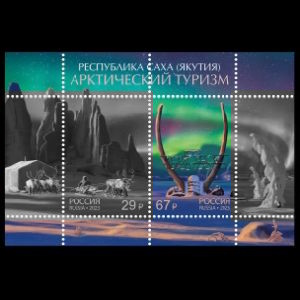 |
 |
|
| ?.2023 Argentina [O6] | 15.05.2023 Russia Boycott Russia [O5] | 15.05.2023 Russia Boycott Russia [O4] |
 |
 |
 |
| 17.07.2023 France [O3] | 06.07.2023 Jersey [O2] | |
 |
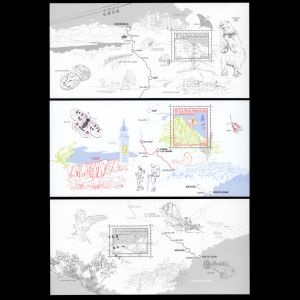 |
 |
| 20.06.2023 - United Nations [O1] | ||
| UN Postal Administration (Vienna) | UN Postal Administration (Geneva) | UN Postal Administration (New York City) |
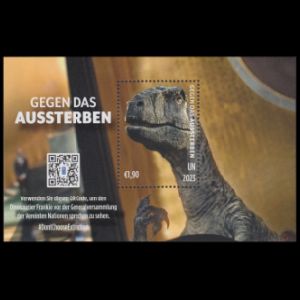 |
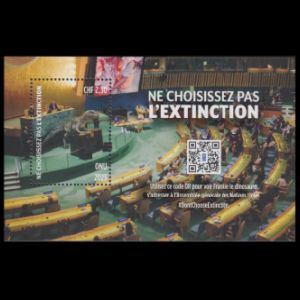 |
 |
Notes:
The campaign calls for an end to fossil fuels and a global transition towards sustainable, green economies. At the heart of the campaign is a short film launched by UNDP featuring an animated dinosaur named Frankie (voiced by actor Jack Black), who storms up to the General Assembly podium at United Nations Headquarters in New York, shocking diplomats and urging world leaders to take action before it is too late. Frankie the Dino calls out Governments for spending billions on fossil fuel subsidies.
The three Souvenir-Sheets feature Frankie the Dino in the General Assembly Hall.
Each sheet has a QR code that when scanned will launch the full video about Frankie addressing world leaders to take action against climate change.
Frankie ends his speech by declaring to the audience: “It’s time for you humans to stop making excuses and start making changes. Don’t Choose Extinction!”.
For more details please click here.
|
[O2] In 1960 Father Christian Burdo re-examined
Saint Brelade's Cave, and excavated the lower layers
where he has found an Acheulean assemblage, a dozen Neandertal teeth as well as mammoth and reindeer bones. The site has produced more Neandertal stone tools than the rest of the British Isles put together. For more information please click here. |
 |

|
 [O3] An Ammonite - symbol of the geological nature reserve of
Haute-Provence - shown at the middle of the Souvenir-Sheet (see on the right).
[O3] An Ammonite - symbol of the geological nature reserve of
Haute-Provence - shown at the middle of the Souvenir-Sheet (see on the right). For more details, please click here.
[O4] Perm (Russian: Пермь), previously known as Yagoshikha (Ягошиха) (1723–1781), and Molotov (Молотов) (1940–1957), is the largest city and the administrative centre of Perm Krai (region), Russia. The city is located on the banks of the Kama River, near the Ural Mountains, and has a population of over one million residents.
In 1723, a copper-smelting work was founded in the village of Yagoshikha. In 1781 the settlement of Yagoshikha became the town of Perm. Perm's position on the navigable Kama River, leading to the Volga, and on the Siberian Route across the Ural Mountains, helped it become an important trade and manufacturing center.
The geologic period of the Permian, last period the Paleozoic Era, takes its name from the region name. The Permian Period derives its name from the Russian region of Perm, where rocks deposited during this time are particularly well developed.
The Permian Period began 298.9 million years ago and ended 252.2 million years ago, extending from the close of the Carboniferous Period to the outset of the Triassic Period.
The concept of the Permian was introduced in 1841 by geologist Sir Roderick Impey Murchison, who named it after the region.Murchison (1792-1871), was a Scottish geologist, who served as director-general of the British Geological Survey from 1855 until his death in 1871. He is noted for investigating and describing the Silurian, Devonian and Permian systems.
Based on explorations in Perm Krai undertaken with Edouard de Verneuil, Murchison gave to the last period of the Paleozoic Era the name of Permian. [R4][O5] Lore Museum of Perm city shown on the left side of the stamp. The museum has several branches distributed all over the city. One of them is the "Museum of Perm Antiquities" which contains a rich collection of fossils collected in the region.
These fossils are of different ages from Permian reptiles to Pleistocene mammals, including "Permian Mammoth" (Mammuthus primigenius). [R5]
 |
 |
| Bosques Petrificados de Jaramillo National Park on stamp of Argentina 2023 | Logo of Bosques Petrificados de Jaramillo National Park |
The Jaramillo Petrified Forest National Park is a protected area of petrified forest located in the Deseado Department, in the northeast of Santa Cruz Province, Argentina.
Formerly part of the site was a natural monument, established in 1954 and known as the Petrified Forest Natural Monument, covering about 13,700 hectares (34,000 acres).
This area has remnants of a forest preserved in stone, that had been growing on the site before the upthrust of the Andes some 150 million years ago.
In December 2012, further land was added and the protected area was reclassified as a national park with a total area of 78,543 hectares (194,080 acres). [R6]
[O7] Milutin Milankovitch (1879 – 1958) was a civil engineer, mathematician, astronomer, climatologist and popularizer of science.
Full professor of celestial mechanics, dean of the Faculty of Philosophy, director of the Astronomical Observatory in Belgrade and vice president of SASA, he was remembered in the history of science, first of all, for his theory about changes in the Earth's climate over a long period of time, known as Milankovitch cycles, as well as the reform of the Julian calendar.

|
| Sculptural composition in the form of mammoth tusks with the inscription "Verkhoyansk is the Cold Pole". Image credit Wikipedia |
[O8] The third stamp on the Mini-Sheet "Arctic tourism" shows a sculptural composition in the form of mammoth tusks with the inscription "Verkhoyansk is the Cold Pole" (see on the right).
Verkhoyansk (Russian: Верхоянск) is a town in Verkhoyansky District of the Sakha Republic, Russia. It is located on the Yana River in the Arctic Circle, 675 kilometers north of Yakutsk, the capital of the Sakha republic. As of the 2010 Census, its population was 1,311. Verkhoyansk holds the record for the hottest temperature ever recorded north of the Arctic Circle, with +38.0°C, and it also holds the record for the coldest temperature ever recorded in Asia, −67.8°C.
Official and personalized commemorative Postal Stationaries related to Paleontology and Paleoanthropology: fossils, dinosaurs and other prehistoric animals
| 19.04.2023 - Spain | 07.04.2023 - Bulgaria | 24.03.2023 - Czech Republic [Sp] |
 |
 |
 |
Notes:
[PSO1] The Fauna-Flora Philatelic Society of Prague, issued the personalized postal stationery (customized cachet on standard postal stationery) with Deinotherium on the cachet. The postal stationery was offered in Sberatel philatelic stamps show on March 24th 2023, in Prague, together with the booklet of 8 self-adhesive stamps "Tertiary period animals".
The illustration on the cachet was made by Arnošt Hanák, who was present at the show and held an autograph session. [R7]
The Deinotherium skeleton was discovered near Horni Ves in Chebsk in 1883 and became a part of the collection of the Natural History Museum in Vienna.
Special covers related to Paleontology and Paleoanthropology: fossils, dinosaurs and other prehistoric animals
| xx.xx.2023 - Mongolia | "Ichthyosaurs" article published in August 2023 issue of the STAMP magazine (UK) is the very short version of The History of the Discovery of Ichthyosaurs, written for this website in 2021. | |
 |
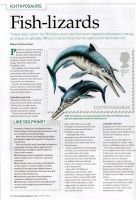 |
|
Commemorative Postmarks directly related to Paleontology and Paleoanthropology: dinosaurs and other prehistoric animals, fossils, human ancestors, paleontologists
Legend is here| 12.12.2023 Peru [FDC] | 15.11.2023 China [Sp] | 08.09.2023 Czech Republic [Sp] |
 |
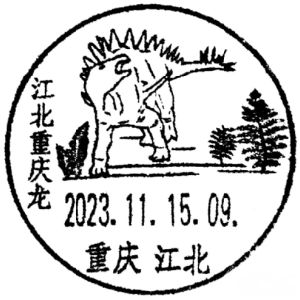 |
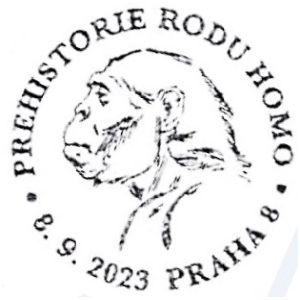 |
| 07.08.2023 China [Sp] | 28.07.2023 Mexico [FDC] | |
 |
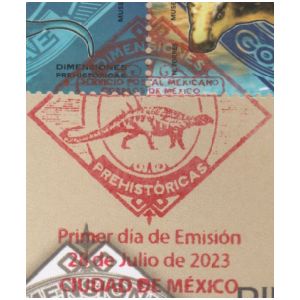 |
|
| 20.06.2023 - United Nations [O1] [FDC] | ||
| UN Postal Administration - Vienna | UN Postal Administration - Geneva | UN Postal Administration - New York |
 |
 |
 |
| 18.05.2023 - 17.05.2024 China [Sp] [PM3] | 27.04 - 01.05.2023 China [Sp] | |
 |
 |
 |
| 22.04.2023 - Czech Republic [Sp] | 21.04.2023 - Spain [Sp] | 20.04.2023 - Czech Republic [Sp] |
 |
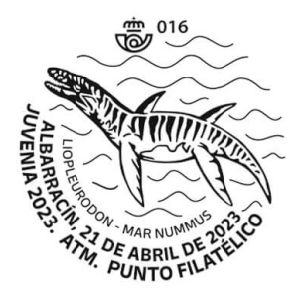 |
 |
| 19.04.2023 - Spain [FDC] | ||
 |
 |
 |
| 19.04.2023 - Spain [FDC] | 07.04.2023 - Bulgaria [FDC] | 24.03.2023 - Czech Republic [Sp] |
 |
 |
 |
| 17.03.2023 - Czech Republic [Sp] [PM2] | 17.03.2023 - Czech Republic [Sp] | 17.02.2023 - Russia Boycott Russia PM1 |
 |
 |
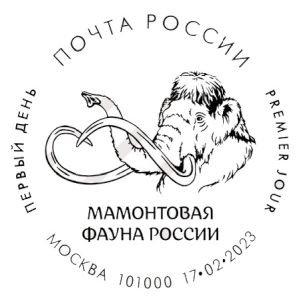 |
Notes:
[PM1] There are 11 FDC's postmarks issued by the Russian Post - the same design, but different cities.
[PM2] The dinosaur Burianosaurus augustai was named after famous Czech paleontologist Josef Augusta in 2017.
Josef Augusta (1903-1968) was a Czech paleontologist, geologist, and science popularizer. Between 1933 and 1968 he held posts at the Charles University in Prague as lecturer, professor, and dean of the faculty. Augusta is best known for his reconstructions of fossil flora and fauna, together with the painter Zdeněk Burian (1905–1981). [R1]
[PM3] The self-adhesive meterfranking label, with "Kunming fish" fossil (Haikouichthys) on the label in the middle.
Haikouichthys is an extinct genus of craniate (animals with notochords and distinct heads) that lived 518 million years ago. Haikouichthys had a defined skull and other characteristics that have led paleontologists to label it a true craniate, and even to be popularly characterized as one of the earliest fishes. The holotype of Haikouichthys ercaicunensis was found in the Yuansshan member of the Qiongzhusi Formation in the 'Eoredlichia' Zone near Haikou at Ercaicun, Kunming City, Yunnan, China, hence its name "Haikou fish from Ercaicun". The fossil of "Kunming fish" is the earliest vertebrate found so far, which provides an important basis for the evolution from fish to man. [R2]

An example of the circulated commemorative cover is here.
[PM4]
|
On August 8th, 2023, the Shanghai Mass Art Museum, after two years of interruption
due to the COVID pandemic, organized the "Dinosaur Resurrection" event.
[R3] The event was integrated with multiple elements such as markets, lectures, handicrafts, and joint writing films, so that the friends who came to participate in the event spent a rich day and attracted many dinosaurs lovers. The special guest of the event was Spanish Post, who presented their postage stamp and related philatelic products "Aragonese dragon (Aragosaurus ischiaticus)", issued in April this year. Chinese Post introduced the meter franking with five "Chinese Dinosaurs" and the postcrossing postcard: |

|
 |
Some commemorative postmarks to consider: contributors to Paleoanthropology
Legend is here| 21.12.2023 - Mongolia [FDC] | ||
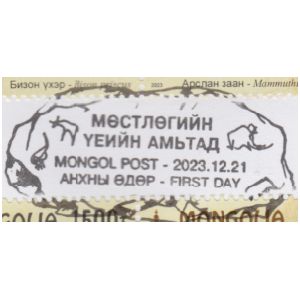 |
References:

|
- [R1] Josef Augusta: Wikipedia,
- [R2] "Kunming fish", Haikouichthys: Wikipedia,
- [R3] "Dinosaur Resurrection" event of : [1], [2],
- [R4] Perm and Permian Period:
- Perm city: Wikipedia.
- Permian Period : Wikipedia, Encyclopedia Britannica,
- [R5] Lore Museum of Perm city: official website, Permian branch of the Museum,
- [R6] Bosques Petrificados de Jaramillo National Park: Wikipedia.
- [R7] Czech paleoartists:
- Arnost Hanak: official homepage, idnes.cz, Muzeum Cheb.
- Jan Sovak: Wikipedia.
- Petr Modlitba: official homepage, albatrosmedia.eue, brnensky.denik.cz.
- [R8] Milutin Milankovitch: Wikipedia
Acknowledgements:
- Many thanks to Dr. Peter Voice from Department of Geological and Environmental Sciences, Western Michigan University, for the draft page review and his valuable comments.
- Many thanks to fellow collector Peter Brandhuber from Germany for his help finding information about stamps and postmarks listed in this article.
| <<2024 | index | 2022>> |